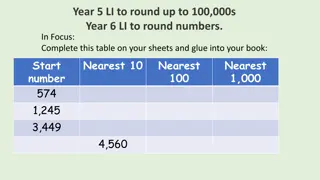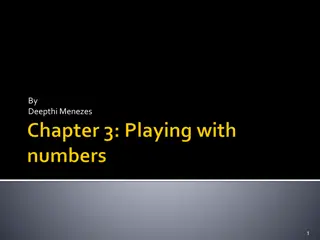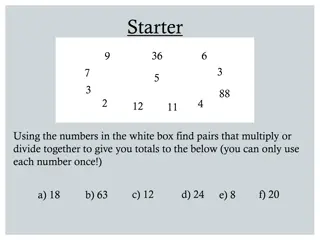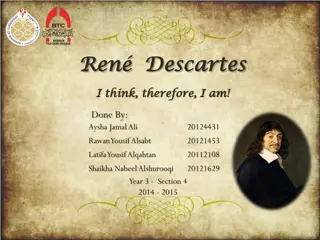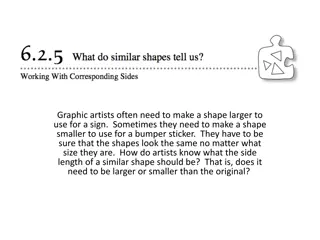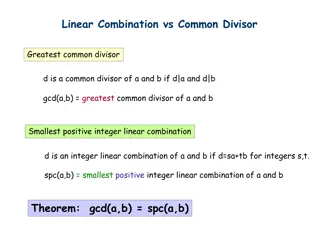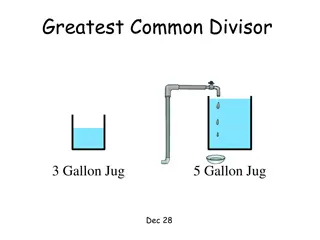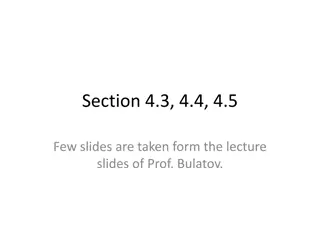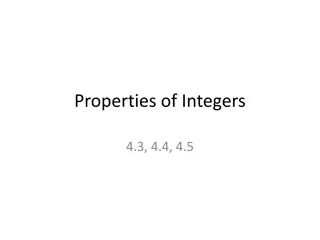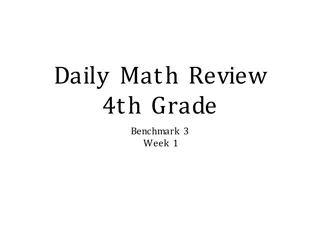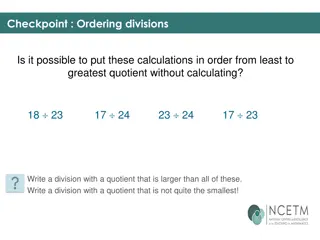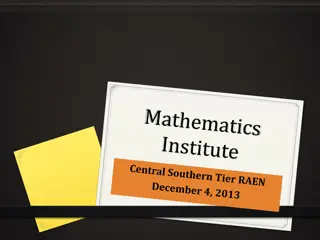Exploring Factors, Multiples, and Divisors in Mathematics
Dive into the concepts of factors, multiples, and divisors through visual representations of arranging stars and footballs in various ways. Understand how numbers like 6 and 8 can be written as products of different factors, and learn about division concepts such as exact divisors and remainders. Explore the relationship between numbers and their divisors through engaging illustrations.
Download Presentation

Please find below an Image/Link to download the presentation.
The content on the website is provided AS IS for your information and personal use only. It may not be sold, licensed, or shared on other websites without obtaining consent from the author. Download presentation by click this link. If you encounter any issues during the download, it is possible that the publisher has removed the file from their server.
E N D
Presentation Transcript
FACTORS & MULTIPLES R.USHA TGT ( MATHEMATICS) KV,GILL NAGAR CHENNAI. Powerpoint hosted on www.worldofteaching.com Please visit for 100 s more free powerpoints 1
ARRANGEMENT OF STARS Take 6 stars and arrange them in different ways 2
6 Rows 1 Star/Row = 6 Stars 6
As we can see, 6 can be written as product of two numbers in many ways: 6 = 1 6 6 = 2 3 6 = 3 2 6 = 6 1 1, 2, 3 and 6 are exact divisors of 6 7
ARRANGEMENT OF FOOTBALLS Take 8 footballs and arrange them in different ways 8
Arrangement of 8 in different ways 1 Row 8 Balls/Row = 8 Balls 9
4 Rows 2 Balls / Row = 8 Balls 11
8 Rows 1 Ball / Row = 8 Balls 12
1, 2, 4 and 8 are exact divisors of 8. 13
7 divides 28 exactly and gives Quotient 4 and Remainder 0. 28 7 = 4 14
4 divides 28 exactly and gives Quotient 7 and Remainder 0. 28 4 = 7 15
28 divides 28 exactly and gives Quotient 1 and Remainder 0. 28 28 = 1 16
FACTORS OF 28 1 4 7 28 1 = 28 28 4 = 7 28 7 = 4 28 28= 1 28 17
FACTORS OF 16 16 1 = 16 16 2 = 8 16 4 = 4 16 8 = 2 16 16 = 1 16 16 1 1 2 2 4 4 8 8 18
FACTOR A factor of a number is an exact divisor of that number i.e. the factor leaves remainder 0 when it divides the number. 19
4 5 = 20 4 and 5 are factors of 20. We can also say that 20 is multiple of 4 and 5. In 2 12 = 24, 2 and 12 are factors of 24. 24 is the multiple of 2 and 12. So, a number is a multiple of its factors. 20
Multiples of 2 = 2,4,6,8,10,12,14,16,18,20,22,24 Multiples of 3 = 3,6,9,12,15,18,21,24,27,30,33,36, Multiples of 15 = 15,30,4,60,75,90,105,120,135, The number of multiples of a given number is infinite. 21
FACTORS OF SOME NUMBERS 8 = 1,2,4,8 16 = 1,2,4,8,16 25 = 1,5,25 22
4 5 = 20 Factors Multiple 23
POINTS TO REMEMBER 1 is a factor of every number. Every factor of a number is an exact divisor of that number. Every factor is less than or equal to the given number. Number of factors of a given number are finite. 24
POINTS TO REMEMBER contd Every multiple of a number is greater than or equal to that number. The number of multiples of a given number is infinite. Every number is a multiple of itself. 25
FACTOR OR MULTIPLE? For each of numbers in the statements, select either multiple [M] or factor [F] 34 5 = 170 [F] [M] [F] [M] [F] [M] 25 4 = 100 [F] [M] [F] [M] [F] [M] 90 10 = 900 [F] [M] [F] [M] [F] [M] 45 6 = 270 [F] [M] [F] [M] [F] [M] 7 30 = 210 [F] [M] [F] [M] [F] [M] 26
State whether the following statements are TRUE or FALSE 1. 1 is a factor of every number. F T 2. The largest factor of any number is the number itself. F T 3. Number of factors of a given number is infinite. F T 4.The number of multiples of 5 is 10. F T 5.The factors of 65 are 1, 5 and 13 only. F T ( Click F for false and T for true ) 27
THANK YOU 28
CORRECT 29
WRONG 30



